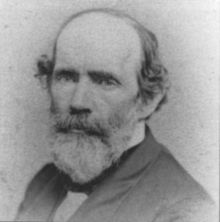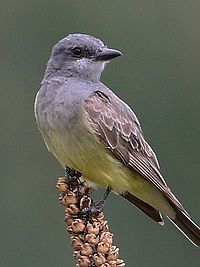John Cassin
John Cassin | |
|---|---|
 | |
| Born | September 6, 1813 |
| Died | 10 January 1869(aged 55) Philadelphia,Pennsylvania,U.S. |
| Resting place | Laurel Hill Cemetery,Philadelphia, Pennsylvania, U.S. |
| Known for |
|
| Scientific career | |
| Fields | Ornithology,Naturalist |
John Cassin(September 6, 1813 – January 10, 1869) was an Americanornithologistfrom Pennsylvania. He worked ascuratorand Vice President at thePhiladelphia Academy of Natural Sciencesand focused on the systemic classification of the Academy's extensive collection of birds. He was one of the founders of theDelaware County Institute of Scienceand published several books describing 194 new species of birds. Five species of North American birds, a cicada, and a mineral are named in his honor.
Early life and education
[edit]Cassin was born inUpper Providence Township, Pennsylvaniaon September 6, 1813. He was educated at theWesttown SchoolinWesttown Township, Pennsylvania.[1]His great Uncle,John Cassin,was a commodore in the U.S. Navy and served in the War of 1812.[2]
He served in theUnion Armyduring theAmerican Civil Warand was held prisoner in the infamous ConfederateLibby PrisoninRichmond, Virginia.[3]
Career
[edit]Cassin moved to Philadelphia in 1834 and became the head of alithographingbusiness in which many of his illustrations of birds were later printed.[4]He served for a brief time in thePhiladelphia City Council.[5]He was a member of theZoological Society,theAmerican Philosophical Societyand thePennsylvania Historical Society.[2]
In 1833, Cassin, along with 4 colleagues, founded the Delaware County Institute of Science inMedia, Pennsylvania.[6]
In 1842, he was elected curator of the Philadelphia Academy of Natural Sciences.[4]From 1846 to 1850,Thomas Bellerby Wilson,a wealthy patron of the Academy, became interested in the department of ornithology and procured a collection of over 25,000 birds.[7]The Academy had the largest ornithological collection in the United States at the time and included an extensive collection of non-North American species.[8]This exceptional collection of birds allowed Cassin to become the leading ornithologicaltaxonomistin the world.[2]
Cassin worked almost exclusively at the Academy, focused on research and the systematic classification of species rather than field work.[9]He described 194 new species of birds[7]and revised a number of families in the Academy's publications. His publications includeBirds of California,with descriptions and colored engravings of fifty species;Synopsis of the Birds of North America;Ornithology of the United States Exploring Expedition;Ornithology of the Japan Expedition;Ornithology of Gillis's Astronomical Expedition to Chile;and chapters on raptorial birds and waders inOrnithology of the Pacific Railroad Explorations and Surveys.[10]He also co-authoredBirds of North America(1860) withSpencer Fullerton BairdandGeorge Newbold Lawrence.

Specimens collected from thePacific Railroad Surveysand the Mexican Boundary Surveys were sent to the Academy and further supplemented the collection. Cassin helped revise the publications that arose from these surveys.[11]
Martha Maxwellwas a student of Cassin at the Academy of Natural Sciences from 1862 to 1869.[12]
Cassin was elected Vice President of the Academy of Natural Sciences in 1864.[4]
He died in 1869 ofarsenic poisoningcaused by his handling of bird skins preserved with arsenic.[13]His collection of 4,300 birds was purchased for $500, equivalent to $11,445 in 2023 dollars, byJohn Whipple Potter JenksforBrown University's museum of natural history.[14]
He is buried atLaurel Hill Cemeteryin Philadelphia.[2]
Legacy
[edit]
Five birds from North America are named in his honor: theCassin's auklet,Cassin's kingbird,Cassin's vireo,Cassin's sparrow,andCassin's finch.[15]The periodic cicadaMagicicada cassiniand the mineral orthoclase variety cassinite are also named for him.[1]
In 1901, the journal of theDelaware Valley Ornithological Clubwas renamedCassiniain his honor.[16]
Bibliography
[edit]- Catalogue of the caprimulgidae in the Collection of the Academy of Natural Sciences of Philadelphia,Philadelphia, Academy of Natural Sciences of Philadelphia, 1851
- Illustrations of the Birds of California, Texas, Oregon, British, and Russian America.Philadelphia: J. B. Lippincott & Co., 1856
- United States Exploring Expedition. During the Years 1838, 1839, 1840, 1841, 1842. Under the Command of Charles Wilkins, U.S.N.,Philadelphia, C. Sherman & Son, 1858
References
[edit]Citations
- ^ab"Minerals".delcoscience.org.Delaware County Institute of Science.Retrieved23 October2020.
- ^abcdCampbell, John Hugh (1892).History of the Friendly Sons of St. Patrick and the Hibernian Society for the Relief of Emigrants from Ireland.Philadelphia: Hibernian Society. pp. 376–377.Retrieved25 October2020.
- ^Schmauss, Anne."For The Birds: Don't mistake Cassin's finches for house finches".santafenewmexican.Santa Fe New Mexican.Retrieved24 October2020.
- ^abcStone 1901,p. 1.
- ^Stone 1901,pp. 1–2.
- ^Ashmead 1884,pp. 601–602.
- ^abStone 1901,p. 3.
- ^Barrow 1998,p. 24.
- ^Stone 1901,p. 4.
- ^Ashmead 1884,pp. 673–675.
- ^Ashworth, William. B. Jr. (6 September 2017)."Scientist of the Day - John Cassin".lindahall.org.Linda Hall Library.Retrieved25 October2020.
- ^Barrow 1998,p. 43.
- ^Fuller, Harry."Cassin of Philadelphia".towhee.net.Retrieved22 October2020.
- ^Annual Report of the President to the Corporation of Brown University.1869. p. 12.
- ^Serrano, Elizabeth (28 August 2019)."The People Behind the Birds Named For People: John Cassin".allaboutbirds.org.Cornell University.Retrieved21 October2020.
- ^Sutton, Clay (2006).Birds and Birding at Cape May.Mechanicsburg, PA: Stackpole Books. p. 4436.ISBN978-0-8117-3134-8.Retrieved24 October2020.
Sources
- Ashmead, Henry Graham (1884).History of Delaware County, Pennsylvania.L.H. Everts & Co.
- Barrow, Mark V. Jr. (1998).A Passion for Birds: American Ornithology After Audubon.Princeton University Press.ISBN0-691-04402-3.
- Stone, Witmer (1901).Cassinia: A Bird Annual. Proceedings of the Delaware Valley Ornithological Club of Philadelphia, Issues 5-9.Delaware Valley Ornithological Club.
External links
[edit]- Works of John Cassin at the Biodiversity Heritage Library
- Cassin's Sparrow blog atCassinsSparrow.org– Long-running science blog that explores the history of Cassin's Sparrow's discovery, what we've learned about the species since, and why it matters.
- 1813 births
- 1869 deaths
- 19th-century American politicians
- 19th-century American zoologists
- American bird artists
- American ornithologists
- Burials at Laurel Hill Cemetery (Philadelphia)
- Deaths by poisoning
- Members of the American Philosophical Society
- People from Delaware County, Pennsylvania
- People of Pennsylvania in the American Civil War
- Philadelphia City Council members
- Scientists from Philadelphia
- Westtown School alumni
